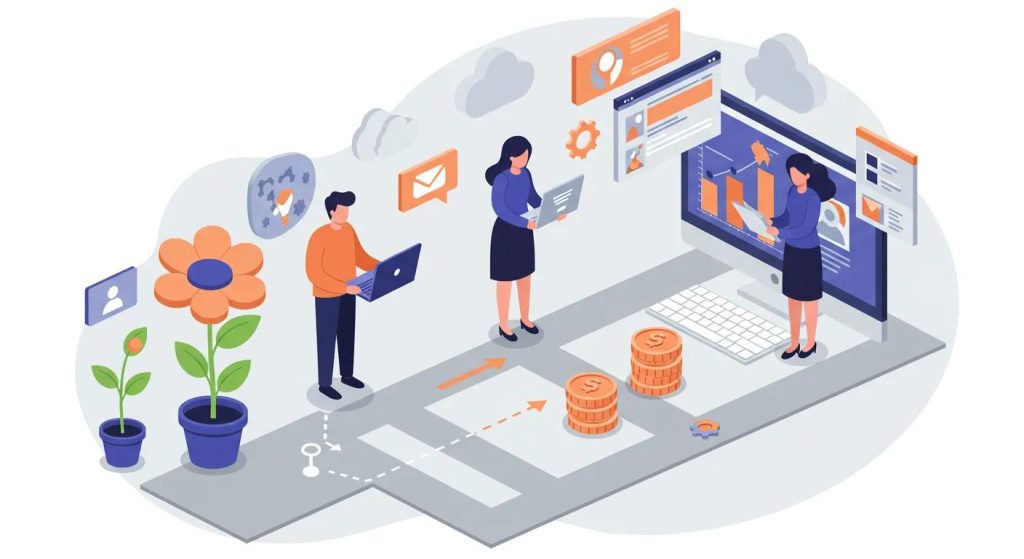Scaling Strategies: Partnering with a Digital Growth Agency
Partnering with a Digital Growth Agency: Your Roadmap to Scaling Online with Proven Services and Measurable Results
Partnering with a digital growth agency means combining strategy, technology, and execution to increase qualified traffic, leads, and revenue. This guide lays out a practical roadmap that defines what a digital growth agency is, compares growth-first approaches to traditional marketing, and explains which services move the needle for online scaling. You will learn how to evaluate agencies, run an effective selection process, and structure the partnership so measurement and optimisation drive predictable returns. The guide covers core services (SEO, PPC, social, web design, pay-per-lead), the benefits of boutique and performance-focused models, onboarding best practices, and the key performance indicators you must track to maximise your return on investment. By the end, you’ll have a step-by-step checklist for choosing an agency, sample tables mapping services to goals and KPIs, and clear governance recommendations to ensure accountability and measurable growth.
What Is a Digital Growth Agency and How Can It Help Scale Your Business Online?
A digital growth agency is a specialised performance marketing partner that combines digital marketing disciplines and analytics to accelerate customer acquisition and revenue growth. It operates by aligning channels—organic search, paid media, social platforms, and conversion-focused web design—around measurable business objectives so tests and investment optimise toward maximising customer value and optimising acquisition investment. The immediate benefit is faster hypothesis-to-test cycles that translate into improved conversion rates and predictable lead flow. As an illustrative example, boutique agencies offer integrated stacks—SEO, PPC, social, web design and pay-per-lead services—that coordinate to shorten acquisition cycles and improve attribution clarity; this is the model many Australian businesses choose when they need local market nuance.
How Does a Digital Growth Agency Differ from Traditional Marketing Agencies?
A growth agency emphasises measurable outcomes and speed, while traditional agencies focus more on brand lift and long-term creative campaigns. Growth teams prioritise key performance indicators such as customer acquisition efficiency, customer lifetime value, conversion rate, and return on ad spend, and use rapid A/B testing and programmatic optimisation to iterate. Technology stacks, attribution models, and analytics-driven roadmaps are core to growth firms, enabling precise budget allocation and accountability. This performance orientation leads naturally to choosing services and metrics that directly impact revenue rather than only awareness.
Which Core Digital Marketing Services Drive Business Growth?

Core services each play a distinct role in the growth stack and combine to form an omnichannel funnel that converts prospects into customers.
Intro: This table shows how core services map to business goals and expected outcomes.
| Service | Primary Goal | Typical KPI | Typical Timeline |
|---|---|---|---|
| SEO services | Increase organic visibility and qualified traffic | Organic sessions, keyword rankings, and leads | 3–9 months |
| PPC management | Rapid demand generation and measurable return on investment | Efficient lead acquisition, return on ad spend, conversions | 1–3 months |
| Social media marketing | Audience engagement and retargeting | Click-through rate, engagement, and efficient lead acquisition | 1–4 months |
| Web design services | Improve conversion rate and user experience | Conversion rate, bounce rate, average order value | 1–2 months |
This comparison clarifies how each service contributes to short- and mid-term growth and why an integrated approach reduces friction between acquisition and conversion.
What Measurable Results Should You Expect from a Digital Growth Agency?
Realistic expectations hinge on baseline performance and channel mix: expect early PPC gains in 4–12 weeks, SEO traction in 3–9 months, and ongoing CRO improvements in the first 30–90 days. Common key performance indicators include organic traffic lift, lead volume, conversion rate improvements, optimised lead acquisition, and increasing return on ad spend, all measured against predefined baselines. Benchmarks vary by industry and audience, so establishing a measurement plan and attribution model up front is critical. Setting these measurable targets enables the agency and client to align incentives and evaluate performance objectively.
What Are the Key Benefits of Partnering with a Digital Marketing Agency for Business Growth?
Partnering with a specialised agency accelerates access to multidisciplinary expertise, advanced tools, and tested playbooks that most in-house teams lack. Agencies centralise campaign execution, reduce time-to-market, and bring governance and reporting discipline so investments become predictable and optimisable. They also provide economies of scale in technology and media buying that lower effective costs for clients while enabling continuous experimentation. Finally, a boutique growth model blends personalised strategy with performance accountability, offering direct lines to senior strategists and tailored roadmaps.
Intro to benefits list: Below are core advantages you can expect from a performance-first agency relationship.
- Faster Scaling: Dedicated teams execute and iterate more quickly than ad hoc in-house efforts.
- Specialist Expertise: Access to channel specialists—SEO, PPC, social, creative and analytics—improves execution quality.
- Predictable Reporting: Regular dashboards and agreed KPIs create transparency and accountability.
Summary: These benefits combine to optimise customer acquisition, increase conversion rates, and create a data-driven growth engine that supports sustainable scaling.
After explaining the benefits for businesses evaluating partners, Results Agency exemplifies the boutique growth model with a full-service offering and a strong commitment to delivering measurable outcomes, emphasising personalised strategy and Australian market experience; organisations often cite this dedication to results and local focus when selecting a partner.
How Does a Boutique Growth Agency Provide Personalised Strategies and Measurable Outcomes?
Boutique growth agencies pair small, senior-led teams with bespoke strategies that align tightly with client goals, which increases responsiveness and strategic clarity. Our commitment to your success is structured around specific, measurable milestones and performance-based deliverables, ensuring clear alignment between our efforts and your business objectives. We establish clear baselines, consistent reporting, and transparent agreements to foster a strong, results-driven partnership. This model trades broad scale for focused impact, making it a preferred choice for businesses seeking accountable growth.
Why Is Access to Expert Teams and Advanced Technology Critical for Scaling Online?
Expert teams bring deep channel know-how—keyword strategy for SEO, bid automation for PPC, creative testing for social—and pair it with advanced tooling like analytics platforms and AI-assisted optimisation. Technology accelerates testing cadence and improves signal-to-noise in attribution, enabling the agency to prioritise investments with the highest return on investment. These efficiencies optimise your investment in lead generation and improve conversion velocity, which compounds into stronger customer value and acquisition efficiency over time. The next section explains how to validate these capabilities when choosing a partner.
How Can a Local Australian Agency Enhance Your Market Reach and Online Presence?
A local agency provides cultural and regulatory insight, timezone alignment, and the ability to run campaigns tailored to Australian consumer behaviours. Local knowledge improves keyword targeting for regional search patterns and refines messaging to match local intent signals. Operational advantages include easier coordination for workshops and faster response times for campaign pivots. For businesses selling primarily in Australia, local market expertise reduces wasted investment and accelerates product-market fit.
How Do You Choose the Right Digital Growth Agency for Your Business?
Choosing the right partner requires a structured evaluation: clarify goals, request relevant case studies, test with a pilot, and assess measurement and governance rigour. A concise checklist helps surface red flags such as opaque reporting, one-size-fits-all playbooks, or unclear terms regarding performance. Validate any agency’s commitment to results by asking for baseline metrics and transparent measurement methods; firms that can clearly map actions to outcomes are preferable. If you want to explore a performance-driven approach and local expertise, contacting a boutique Australian provider like Results Agency can provide a practical discussion about measurable commitments.
Intro to selection steps list: Follow these steps to evaluate agencies with clarity.
- Define objectives: Specify revenue, lead, or conversion goals with timelines.
- Request evidence: Ask for case studies and KPIs relevant to your industry.
- Pilot/test: Start with a scoped pilot to validate execution and reporting.
Summary: This structured approach reduces risk and surfaces which partner can truly deliver measurable growth.
What Are the Essential Questions to Ask When Evaluating Digital Marketing Agencies?
Ask about measurable outcomes, reporting cadence, team structure, technology stack, pricing models, and how they ensure performance. Ideal answers include clear examples of past KPIs, access to named specialists, transparent reporting dashboards, and a willingness to run a time-boxed pilot. Also probe for how the agency attributes conversions across channels and how it ties investment to business outcomes. These questions distinguish tactical vendors from strategic growth partners and help you understand how a partner approaches measurable outcomes.
| Evaluation Question | Why It Matters | Red/Amber/Green Signal |
|---|---|---|
| Can you show relevant KPI outcomes? | Demonstrates track record and relevance | Red: Vague metrics / Green: Specific before/after KPIs |
| What is your reporting cadence? | Ensures accountability and optimisation pace | Red: Ad hoc updates / Green: Weekly + monthly dashboards |
| How do you ensure measurable outcomes? | Defines shared commitment and expectations | Red: Vague promises / Green: Milestone-based, measurable metrics and clear accountability |
This checklist clarifies which responses indicate a trustworthy partner and which should prompt caution.
How Does an Agency’s Commitment to Performance Impact Your Partnership?
A strong commitment to performance means the agency shares in the success and focuses on clear baselining and milestones. We structure our partnerships around specific, measurable objectives, such as achieving certain milestones or optimising lead acquisition within agreed parameters. This approach ensures clear expectations and alignment. We recommend insisting on transparent measurement methods and defined conditions for success to ensure a truly collaborative and accountable partnership.
What Is the Step-by-Step Process for Selecting a Digital Growth Agency?
- Discovery: Share goals and gather initial proposals.
- RFP & Shortlist: Request proposals focused on your KPIs and shortlist credible partners.
- Pilot: Run a limited-scope paid test or channel pilot for 6–12 weeks.
- Review: Evaluate pilot metrics, references, and governance fit.
- Contract & Onboard: Agree on terms, KPIs, and reporting before scaling.
These steps protect your investment while proving the agency’s ability to deliver measurable results.
What Does the Partnership Journey Look Like When Scaling Your Business Online?

A successful partnership follows a lifecycle: discovery and audit, prioritised roadmapping, rapid experimentation and optimisation, then scale and governance. Onboarding sets baselines, defines KPIs, and establishes reporting and decision rights; execution uses sprints and A/B testing to deliver quick wins while building longer-term channels. Governance includes shared dashboards, fortnightly reviews, and quarterly strategy resets that align tactics with evolving business outcomes. Below is an example 30–60–90 onboarding checklist you can expect from a best-practice boutique agency.
Intro to onboarding checklist: Use this to validate an agency’s initial plan.
- 30 days: Complete audits, set KPIs, launch high-priority tests.
- 60 days: Optimise early campaigns, refine targeting and creative.
- 90 days: Scale winning channels and formalise reporting cadence.
Summary: Clear onboarding and iterative sprints establish momentum and create a measurable path to scale; many boutique agencies document similar processes as part of their client onboarding work.
How Does the Onboarding Process Set the Stage for Successful Growth?
Onboarding begins with technical and marketing audits to establish baselines for analytics, conversion funnels, and creative assets. Agreeing on KPIs and reporting cadence within the first 30 days creates the governance needed for rapid iteration. Setting quick-win priorities—such as PPC bid adjustments or CRO tests—helps demonstrate early value while longer-term SEO and content programs ramp. These initial steps feed directly into a sprint-based optimisation rhythm that keeps experimentation focused on measurable business outcomes.
What Collaborative Strategies Ensure Continuous Optimisation and Long-Term Success?
Continuous optimisation relies on shared dashboards, clear experiment prioritisation, and regular performance reviews that translate data into decisions. Governance models define roles—who owns creative, who signs off on investment shifts, and how test results inform roadmap changes. A culture of joint planning, hypothesis-driven tests, and transparent attribution accelerates learning and compounds gains. These collaborative structures reduce friction and ensure the agency’s work consistently aligns with the client’s evolving commercial priorities.
How Can You Maximise ROI and Sustainable Growth Through a Digital Marketing Partnership?
Maximising your return on investment requires prioritising the right KPIs, aligning investment to high-impact tests, and ensuring fast feedback loops between creative, media, and analytics. Focus on metrics that map directly to business outcomes—such as optimising customer acquisition, maximising customer lifetime value, improving conversion rate, and ensuring a strong return on investment—and use a consistent attribution model to allocate your marketing investment effectively. Regular experiments, predictive analytics, and incremental investment shifts toward winning segments shorten optimisation cycles and compound returns. The table below maps KPIs to reporting cadence and ownership to clarify accountability between agency and client.
Intro: This table aligns KPIs with reporting frequency and the responsible party to prevent ownership gaps.
| KPI | Reporting Cadence | Responsible Party |
|---|---|---|
| Lead Cost Efficiency | Weekly | Agency runs; Client validates lead quality |
| Conversion Rate | Weekly | Agency implements CRO; Client approves changes |
| Return on Investment / Revenue | Monthly | Shared; finance reconciles revenue attribution |
Summary: Clear KPI ownership and cadence ensure both agency and client can act quickly and maintain shared accountability for your return on investment.
Which Key Metrics and KPIs Should You Track with Your Agency?
Focus on a concise set of primary KPIs: traffic quality (organic/paid sessions), leads (volume and efficiency), conversion rate, customer acquisition efficiency, customer lifetime value, and return on investment. Set realistic thresholds for each metric and define actions tied to performance bands—e.g., increase investment for return on investment above target, pause channels with rising lead acquisition costs. Regularly review these KPIs in a shared dashboard to shorten decision cycles and prioritise experiments that improve unit economics.
How Does Data-Driven Decision Making Accelerate Online Business Scaling?
Data-driven decisions come from consistent measurement, rigorous A/B testing, and attribution models that show which channels and creatives drive revenue. Testing reduces uncertainty by converting hypotheses into measurable outcomes, and predictive analytics help prioritise investments with the highest expected return on investment. This scientific approach compresses learning cycles, reducing wasted investment and rapidly scaling what works while discarding underperforming tactics.



